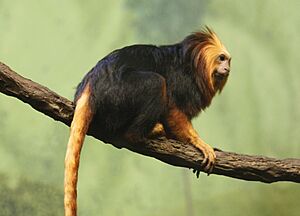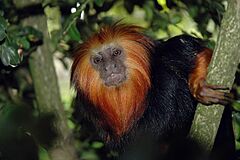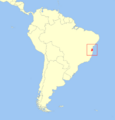Golden-headed lion tamarin facts for kids
Quick facts for kids Golden-headed lion tamarin |
|
|---|---|
 |
|
| Male at the Cincinnati Zoo | |
 |
|
| Female at River Wonders | |
| Conservation status | |
| Scientific classification | |
| Genus: |
Leontopithecus
|
| Species: |
chrysomelas
|
 |
|
| Synonyms | |
|
|
The golden-headed lion tamarin (Leontopithecus chrysomelas) is a small monkey found only in Brazil. It is also called the golden-headed tamarin. These tamarins live in the lowland and mountain forests of the state of Bahia. Because they are found in such a small area, they are considered an endangered species.
Golden-headed lion tamarins usually live in trees, about 3 to 10 meters (10 to 33 feet) high. They prefer old, healthy forests. However, due to habitat destruction, they sometimes have to live in smaller, less ideal forest areas.
These tamarins live in groups of 2 to 11 individuals. The average group size is usually 4 to 7 tamarins. A group might have two adult males, one adult female, and their young. Other groups might have one male, one female, and their young. Sometimes, a group has one breeding pair and their offspring from past years.
Not much is known about how they find partners. Some groups might have one male and one female who stay together. Other groups might have one female with several males. Both male and female tamarins help care for the young. All members of the group also help look after the baby tamarins.
Contents
What Golden-Headed Tamarins Eat
Golden-headed lion tamarins have a very wide diet. They eat plants, fruits, flowers, and nectar. They also hunt insects and small animals without backbones. These include insect larvae, spiders, snails, frogs, lizards, bird eggs, and small snakes.
Scientists have studied their eating habits. They found that these tamarins defend a large area of forest for their size. This area can be from 40 to 320 hectares (about 100 to 790 acres). They use this large area to find enough food.
Tamarins often eat fruits right after they wake up. The sugar from the fruit gives them quick energy for hunting later. They look for animal prey inside plants called epiphytic bromeliads. These plants grow on other plants. If there are not many bromeliads, they also search in tree holes, between palm fronds, and in leaf litter. They sometimes eat tree sap, but this is rare for them. Since their forest home is usually stable, they can find their favorite foods all year. This means they don't often need to eat less nutritious foods like tree sap.
How Golden-Headed Tamarins Behave
Studies show that golden-headed lion tamarins spend about half their time in only a small part of their home range. Their movements are mostly about finding food. They don't spend as much time defending their territory.
Groups of tamarins rarely meet other groups. When they do, these meetings are usually aggressive. They involve loud calls, chases, and even fights between the different groups. Golden-headed lion tamarins spend a lot of time searching for food and traveling to new feeding spots. It's important to remember that these studies were done in the largest untouched forests where these tamarins live. Their behavior might change in smaller or more broken-up forest areas. For example, in one area called Lemos Maia, groups had much smaller home ranges. This was because their forest was mostly separated from other forests.
Where Golden-Headed Tamarins Live

Golden-headed lion tamarins need a large home range. This helps them find enough fruit and prey over a long time. On average, they defend home ranges that are about 123 hectares (about 300 acres). However, they don't always use their space completely alone. Different tamarin groups might have areas that overlap a little at their edges.
Protecting Golden-Headed Tamarins
The IUCN Red List first listed the golden-headed lion tamarin as endangered in 1982. Brazil is a country with amazing animal and plant life. It has about 14% of all the world's living things. Brazil also has the most different kinds of mammals in the world, with over 530 known species.
The Brazilian Institute of Environment and Renewable Natural Resources (IBAMA) states that 15 out of 24 primates found only in the Atlantic Forest are threatened. The Atlantic Forest in Brazil is one of the most endangered ecosystems on Earth. Most of its original forest has been cut down for farming, mining, ranching, and growing cities.
Scientists have studied the four types of lion tamarins a lot. They have worked on understanding their ecology (how they live in their environment). They also work on captive breeding (raising them in zoos). They try to release tamarins back into the wild. They also move tamarins to new areas and work to restore and protect their habitat. Teaching people about the environment is also a big part of their efforts.
Dangers to Their Survival
The forest in Bahia, Brazil, where these tamarins live, has shrunk to only 2% of its original size. This is because of farming, ranching, mining, and city growth. The Atlantic Forest is now very broken up. This loss of habitat is the main reason why the golden-headed lion tamarin population has declined.
Much of this forest was once used to grow cocoa plants. Farmers used a method called cabruca. This meant they removed smaller trees and replaced them with cocoa trees. Even though this changed the forest, it still left some old, tall trees. These trees gave the tamarins places to find food and sleep.
In 1989, farmers stopped growing cocoa plants because a fungus attacked their crops. The old trees that were once available to the tamarins were then cut down for wood. Land was also cleared for cattle or other crops. Now, the Atlantic Forest is a mix of old, original forest, secondary forest (forest that has grown back), and farm lands.
Efforts to Help Tamarins
In 1980, the Brazilian government created the Una Biological Reserve. This reserve was made to protect the golden-headed lion tamarin and its home. Over the years, the park has slowly grown as the government buys more land. The tamarin population in Una is the largest one in the most untouched forest. There is also a group of 25 golden-headed lion tamarins being raised at the Rio de Janeiro Primate Center. Thanks to a lot of help, scientists believe there are now around 6,000 golden-headed lion tamarins in the wild.
In the early 1990s, a plan called the Landowner's Environmental Protection Plan was started. This plan teaches local communities about why it's important to protect the forest and the tamarin. The plan included conservation activities on over 70% of nearby farms. It taught farmers how to use sustainable agriculture. This means farming in ways that don't harm the tamarin's habitat. The plan also teaches school children, hunters, and forest guards about conservation, property rights, and land use. This way of teaching and involving the community has been very successful in helping the tamarin and their home.
The IBAMA has made many efforts to help all four types of tamarin species. Between 1985 and 1991, IBAMA set up four International Recovery and Management Committees (IRMCs). These committees give official advice to IBAMA on how to help and manage the four species. The Brazilian government recognizes them as expert advisors.
People started to worry about tamarin species in the 1960s. Adelmar Coimbra-Filho pointed out that the golden lion tamarin numbers were quickly dropping. This was due to them being taken out of the country and their homes being destroyed. His work helped create biological reserves to protect lion tamarins. He also started the Rio de Janeiro Primate Center. He was the first person to successfully breed the golden-headed lion tamarin.
From 1983 to 1994, many golden-headed lion tamarins were sent to Japan and Belgium. This was part of the exotic pet trade. IBAMA asked Jeremy Mallinson to create and lead an IRMC for the golden-headed lion tamarin. The first goal of this committee was to bring all the tamarins back to Brazil, and some were returned. These committees promote lion tamarins as a flagship species. This means they use the tamarins to draw attention to the bigger goal. That goal is to save the unique Atlantic Forest, its ecosystem, and its many special plants and animals.
The IRMC has different tasks. These include managing and researching tamarins in zoos. They also have a conservation and education program in Bahia. There's a program to educate landowners about the environment. And they conduct field studies on the tamarins' ecology and behavior in the Federal Una Biological Reserve. They give IBAMA advice on managing tamarin populations and their genes. They suggest research for wild and captive tamarins. They also propose community education programs. They work to expand protected areas by buying land. And they talk to government agencies to support new laws. The IRMC members come from different countries and different fields. They include conservationists, field biologists, zoo biologists, educators, administrators, and IBAMA staff.
Images for kids




